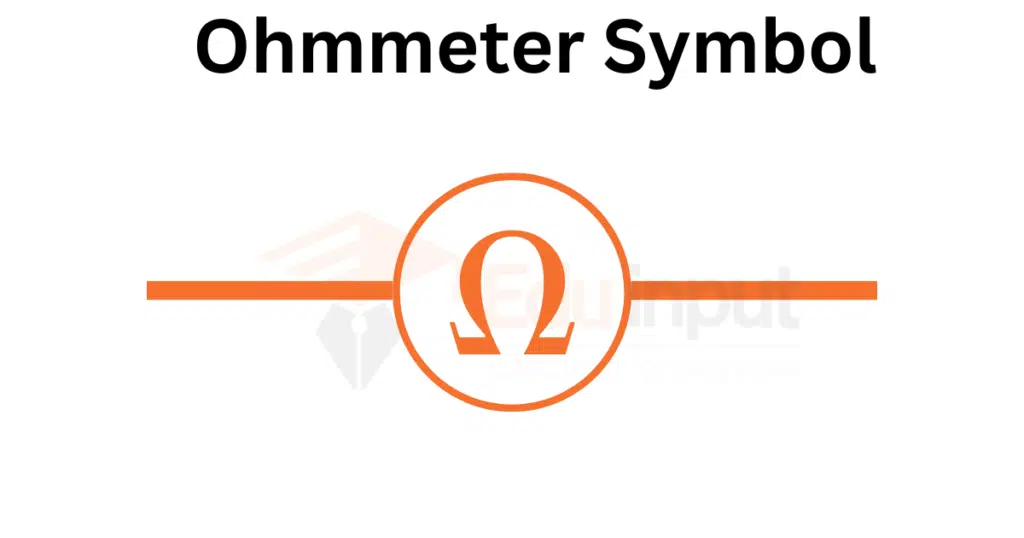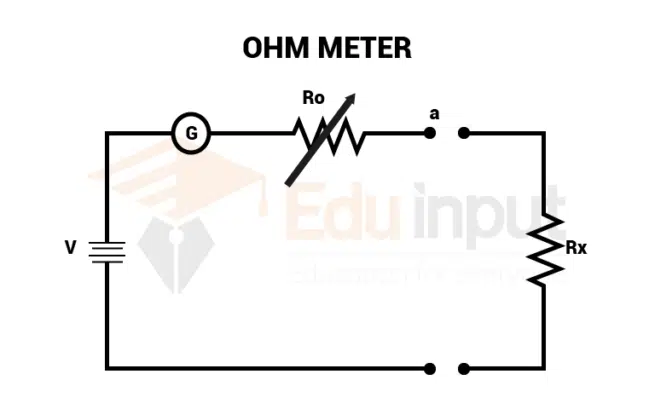What is Ohmmeter?-Types, Application, And Fuction
What is Ohmmeter?
An ohmmeter is a device that measures electrical resistance in ohms. It is often utilized by electricians, engineers, and students in the lab to assess the resistance of resistors, conductors, and other components in an electrical circuit.
The significance of ohmmeters cannot be overstated. These devices enable professionals to accurately measure resistance. Ohmmeters serve as indispensable tools in the electrical and electronic industries whether it’s troubleshooting faulty components, testing conductivity, or verifying circuit integrity.
Ohmmeter Symbol
It’s essential to recognize the ohmmeter symbol when it comes to electrical schematics and circuit diagrams. The ohmmeter symbol typically consists of a circle with an ohm symbol representing the measurement of resistance.

Ohmmeter Circuit
An ohmmeter circuit typically consists of a galvanometer variable a resistance of rs known value and a cell connected in series. The resistance R which is to be measured is connected between terminals c and d. These components work together to apply a known voltage and measure the resulting current, enabling the calculation of resistance.

Ohmmeter Working Principle
An ohmmeter operates on the principle of Ohm’s law, which states that the current flowing through a conductor is directly proportional to the voltage across it and inversely proportional to its resistance.
An ohmmeter applies a known voltage across the component under test and measures the resulting current to measure resistance. The ohmmeter can calculate the resistance value based on the applied voltage and measured current by applying Ohm’s law.
Types of Ohmmeters
Ohmmeters come in different forms with each type catering to specific requirements. The two primary categories of ohmmeters are
Analog Ohmmeter
Analog ohmmeters utilize a mechanical movement mechanism to display resistance readings. These meters employ a needle that moves along a calibrated scale, indicating the resistance value. Although analog ohmmeters may seem outdated in the age of digital technology, they still find applications where continuous readings and analog indications are preferred.
Digital Ohmmeter
Digital ohmmeters, on the other hand, utilize electronic components and display readings on a digital screen. They provide accurate and precise resistance measurements with numerical values. Digital ohmmeters often include additional features such as auto-ranging, data logging, and connectivity options, making them versatile tools for modern applications.
How to Use an Ohmmeter?
Using an ohmmeter correctly is crucial to obtain accurate resistance readings. Here is a step-by-step guide on how to use an ohmmeter effectively:
- Ensure the circuit or component under test is de-energized and disconnected from any power source.
- Select the appropriate ohmmeter range based on the expected resistance value.
- Connect the ohmmeter’s test leads to the terminals of the component being tested.
- Read the resistance value displayed on the ohmmeter. If using a digital ohmmeter, the value will be directly shown on the screen. For analog meters, observe the position of the needle on the calibrated scale.
Ohmmeter Function
The primary function of an ohmmeter is to measure resistance accurately. By providing precise resistance values, ohmmeters assist in various applications, such as:
- Determining the resistance of resistors and other components
- Checking continuity in electrical circuits
- Verifying the integrity of conductive paths
- Diagnosing faults in electronic devices and systems
- Assessing the health of electrical connections
Advantages of Ohmmeters
Ohmmeters offer several advantages that make them indispensable tools in the field of electronics. Some notable advantages include:
- Quick and accurate resistance measurements
- Versatility in measuring various types of components
- Portable and easy to use
- Suitable for both professionals and hobbyists
- Essential for troubleshooting and fault diagnosis
Common Applications of Ohmmeters
Ohmmeters find applications in a wide range of industries and scenarios. Some common applications include:
- Electronics manufacturing and quality control
- Electrical maintenance and repair
- Automotive diagnostics
- Circuit testing and prototyping
- Educational laboratories
- Research and development
Related FAQs
What is an ohmmeter used for?
An ohmmeter is used to measure the electrical resistance of a component or circuit.
What is the measure of ohms?
One ohm is defined as the amount of resistance through which one volt of electrical potential difference will produce a current of one ampere.
What is the unit of an ohmmeter?
The unit of an ohmmeter is ohms (Ω).
What is an ohmmeter also known as?
An ohmmeter is also known as a resistance meter.







Leave a Reply